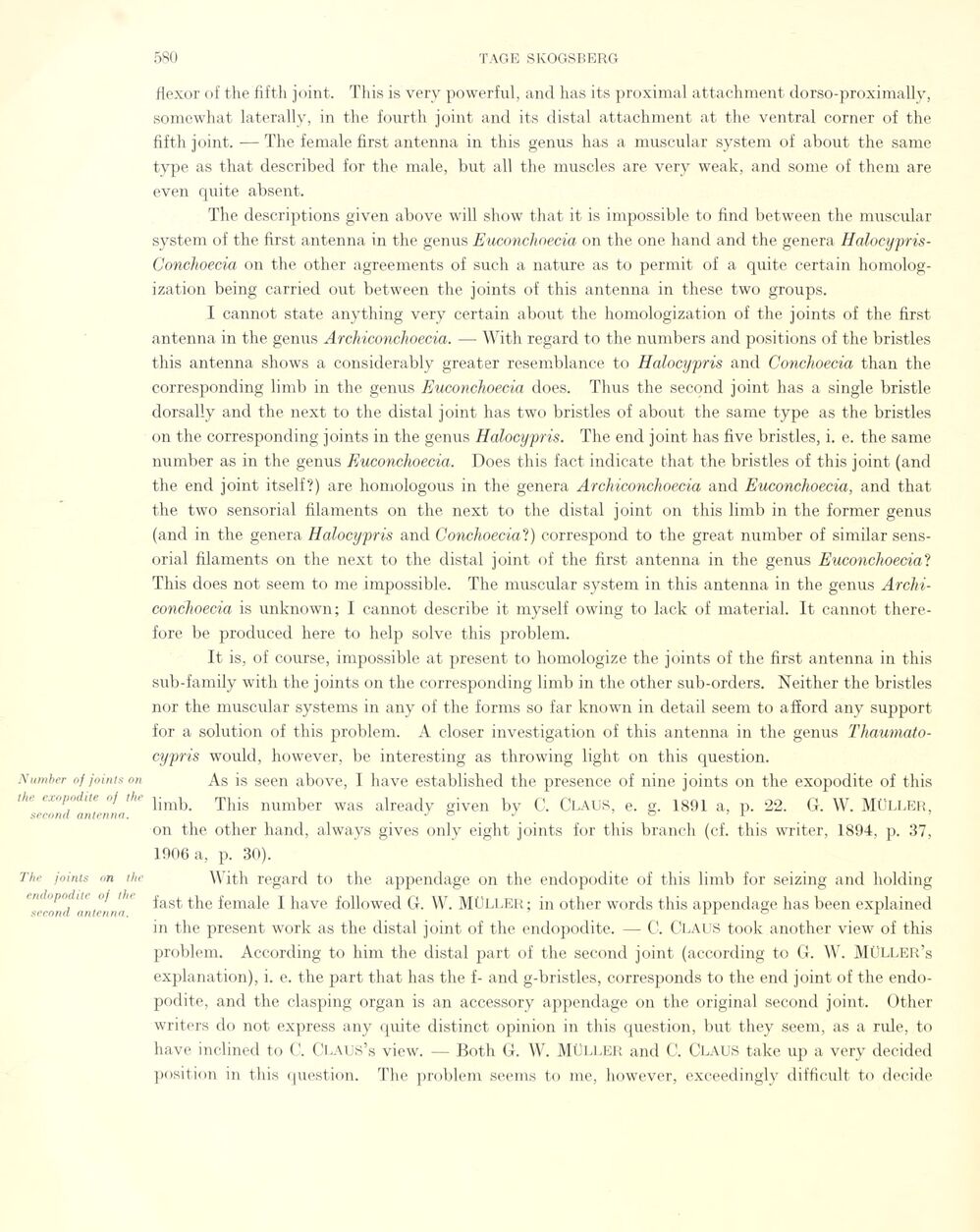
Full resolution (JPEG) - On this page / på denna sida - Sidor ...

<< prev. page << föreg. sida << >> nästa sida >> next page >>
Below is the raw OCR text
from the above scanned image.
Do you see an error? Proofread the page now!
Här nedan syns maskintolkade texten från faksimilbilden ovan.
Ser du något fel? Korrekturläs sidan nu!
This page has never been proofread. / Denna sida har aldrig korrekturlästs.
Number of joints on
the exopodite of the
second antenna.
The joints on the
endopodite of the
second antenna.
flexor of the fifth joint. This is very powerful, and has its proximal attachment dorso-proximally,
somewhat laterally, in the fourth joint and its distal attachment at the ventral corner of the
fifth joint. — The female first antenna in this genus has a muscular system of about the same
type as that described for the male, but all the muscles are very weak, and some of them are
even quite absent.
The descriptions given above will show that it is impossible to find between the muscular
system of the first antenna in the genus Euconchoecia on the one hand and the genera
Halocypris-Conchoecia on the other agreements of such a nature as to permit of a quite certain
homolog-ization being carried out between the joints of this antenna in these two groups.
I cannot state anything very certain about the homologization of the joints of the first
antenna in the genus Archiconchoecia. —- With regard to the numbers and positions of the bristles
this antenna shows a considerably greater resemblance to Halocypris and Conchoecia than the
corresponding limb in the genus Euconchoecia does. Thus the second joint has a single bristle
dorsally and the next to the distal joint has two bristles of about the same type as the bristles
on the corresponding joints in the genus Halocypris. The end joint has five bristles, i. e. the same
number as in the genus Euconchoecia. Does this faet indicate that the bristles of this joint (and
the end joint itself?) are homologous in the genera Archiconchoecia and Euconchoecia, and that
the two sensorial filaments on the next to the distal joint on this limb in the former genus
(and in the genera Halocypris and Conchoecia?) correspond to the great number of similar
sensorial filaments on the next to the distal joint of the first antenna in the genus Euconchoecia?
This does not seem to me impossible. The muscular system in this antenna in the genus
Archiconchoecia is unknown; I cannot describe it rnyself owing to lack of material. It cannot
there-fore be produced here to help solve this problem.
It is, of course, impossible at present to homologize the joints of the first antenna in this
sub-family with the joints on the corresponding limb in the other sub-orders. Neither the bristles
nor the muscular systems in any of the forms so far known in detail seem to afford any support
for a solution of this problem. A doser investigation of this antenna in the genus
Thaumato-cypris would, however, be interesting as throwing light on this question.
As is seen above, I have established the presence of nine joints on the exopodite of this
limb. This number was already given by C. Claus, e. g. 1S91 a, p. 22. G. W. Müller,
on the other hånd, always gives only eight joints for this branch (cf. this writer, 1894, p. 37,
1906 a, p. 30).
With regard to the appendage on the endopodite of this limb for seizing and holding
fast the female I have followed G. W. Müller ; in other words this appendage has been explained
in the present work as the distal joint of the endopodite. — C. Claus took another view of this
problem. According to him the distal part of the second joint (according to G. W. Müller’s
explanation), i. e. the part that has the f- and g-bristles, corresponds to the end joint of the
endopodite, and the clasping organ is an accessory appendage on the original second joint. Other
writers do not express any quite distinet opinion in this question, but they seem, as a rule, to
have inelined to C. Claus’s view. — Both G. W. MÜLLER and C. Claus take up a very decided
position in this question. The problem seems to me, however, exceedingly difficult to decide
<< prev. page << föreg. sida << >> nästa sida >> next page >>